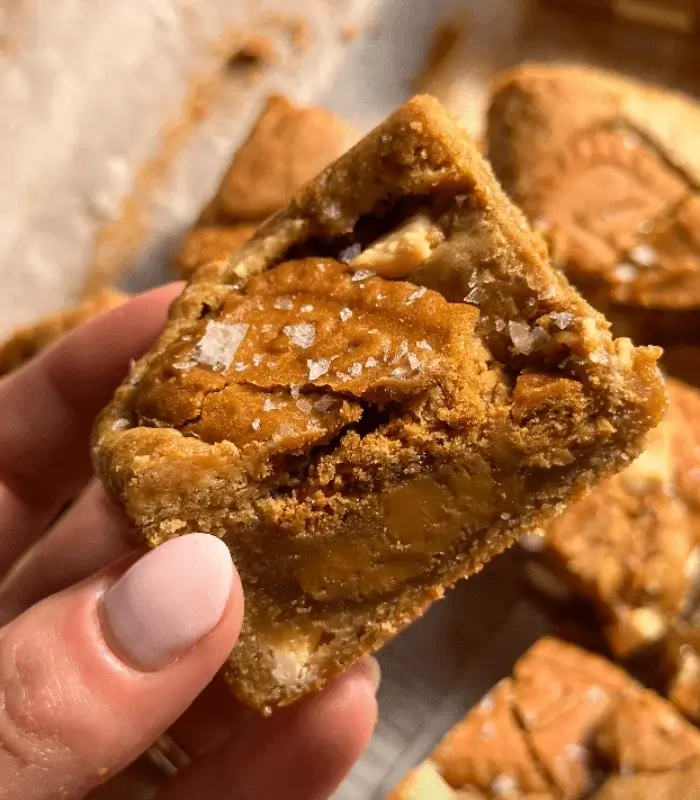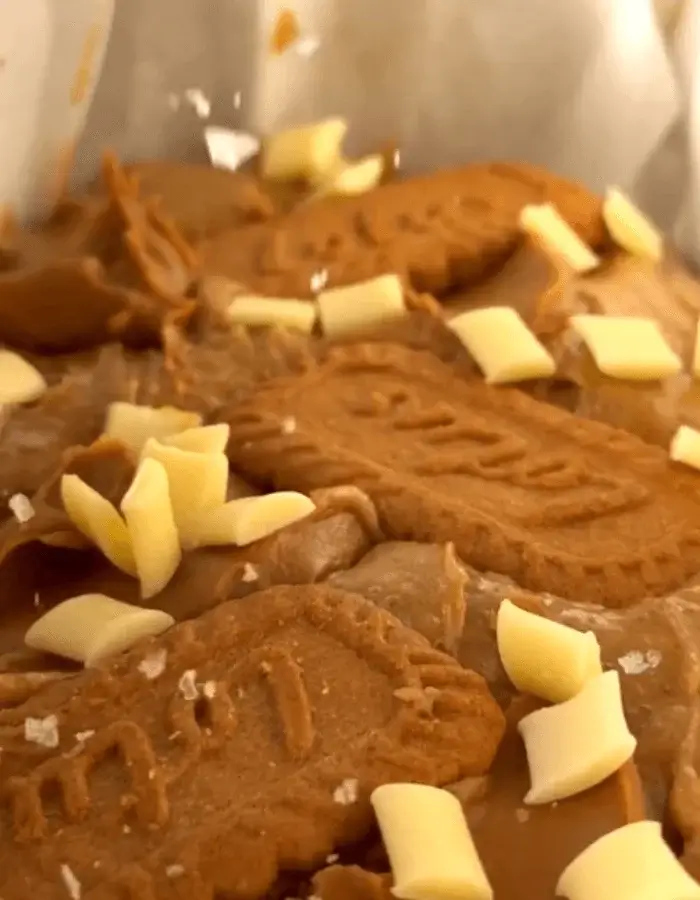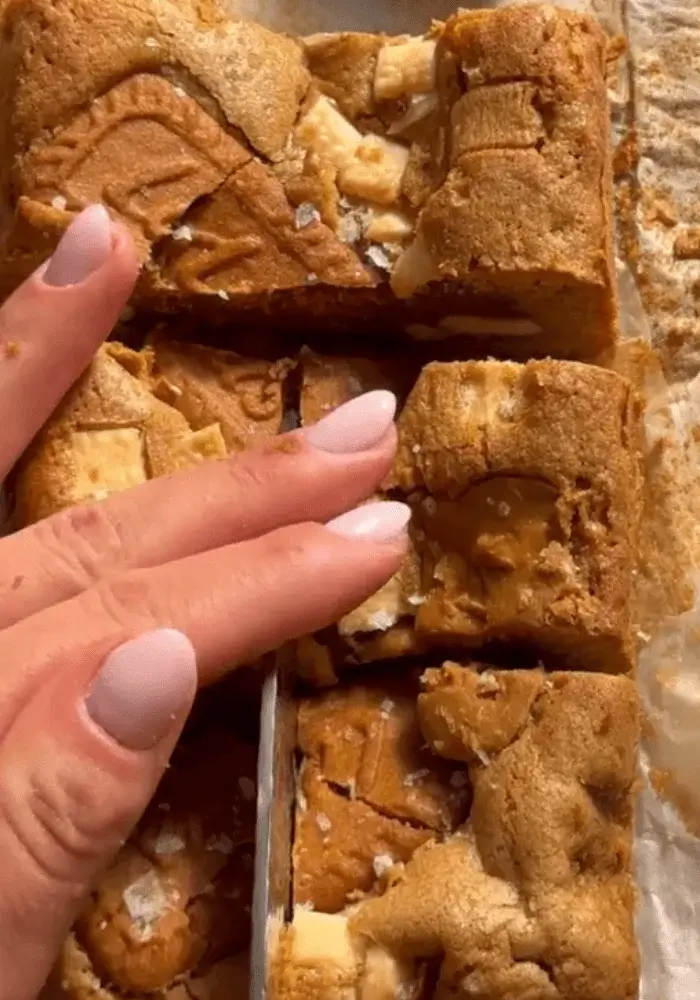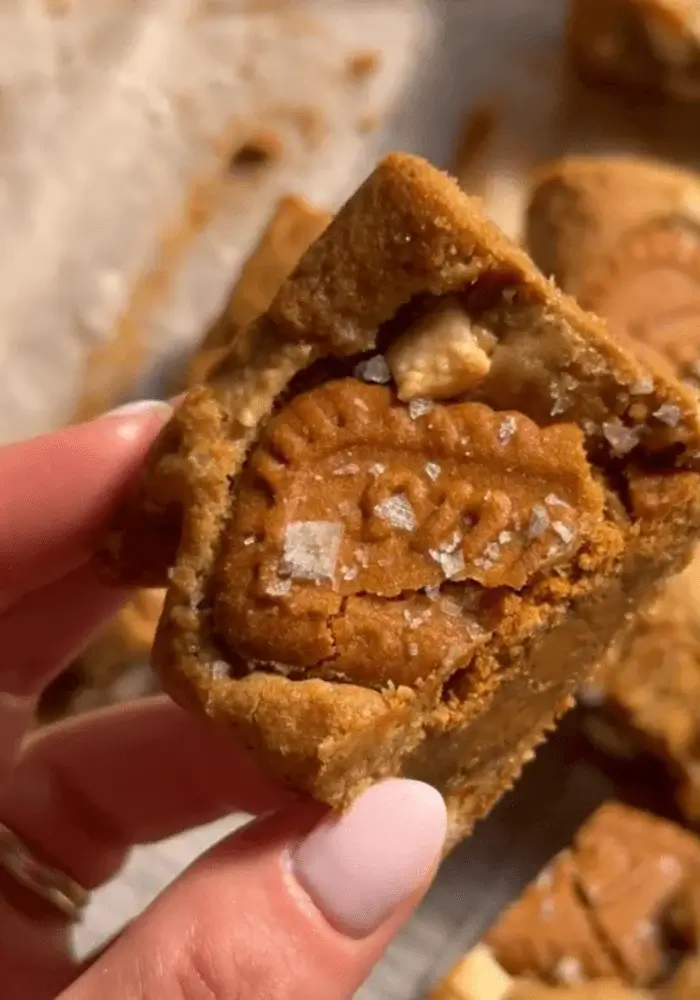White Chocolate Blondies with Lotus Spread
We may earn a commission from recommended products, at no extra cost to you. See Disclosure.
- Loaf pan (8.5 x 4.5-inch/21 x 11 cm)
INGREDIENTS
- 6 tablespoons/90 grams unsalted butter
- ¾ cup/90 grams all-purpose flour
- ¼ cup/60 grams dark brown sugar
- ⅓ cup/70 grams white sugar or sugar substitute
- 1 large egg + 1 large yolk
- 1 teaspoon vanilla bean paste
- ⅓ teaspoon/2 grams baking soda
- 3 Lotus cookies, roughly broken
- 3.5 ounces/100 grams white chocolate, chopped
- 2 tablespoons Lotus spread
- Flaky sea salt, for finishing
INSTRUCTIONS
- Heat the oven to 350°F/175°C. Line a standard loaf pan (8.5 x 4.5-inch/21 x 11 cm) with parchment paper, leaving an overhang on two sides.
- In a small saucepan, melt the butter over low heat, or melt in a microwave-safe bowl using short pulses. Set aside to cool slightly.
- In a large mixing bowl, whisk the melted butter with the brown sugar, white sugar, egg, yolk, and vanilla until smooth and glossy. Add the flour and baking soda and stir until just combined. Fold in three-quarters of the white chocolate, reserving the rest for topping.
- Spoon the Lotus spread in small dollops across the bottom of the prepared pan. Pour in the batter and gently smooth the top with a spatula. Press the broken cookies into the surface and scatter over the remaining white chocolate.
- Transfer the pan to the freezer and chill for 30 minutes. This helps create a fudgier center and neater edges.
- Bake until the top is golden and the center is just set, 22 to 25 minutes. If using a hot or convection oven, check at 20 minutes. For a cakier texture, bake for up to 28 minutes, though the blondies will be less gooey.
- Let the blondies cool slightly, then return to the freezer for 30 minutes to firm before slicing. Sprinkle with flaky salt just before serving. Store leftovers in an airtight container in the refrigerator for up to 4 days.

FAQ
How can I make these white chocolate blondies gluten-free?
Substitute the all-purpose flour with a 1:1 gluten-free baking flour blend that includes xanthan gum or another binder. Avoid using single flours like almond or coconut flour alone, as they absorb moisture differently and can change the texture dramatically. Make sure your white chocolate and Lotus spread are certified gluten-free, since some brands may have trace gluten due to processing. Expect a slightly more delicate structure, so chilling before slicing is even more essential to maintain clean edges and a chewy texture.

Do I need to chill the dough before baking?
Chilling the dough before baking white chocolate blondies is recommended. A 30-minute freeze helps solidify the butter and Lotus spread, preventing them from melting too quickly and making the blondies greasy or flat. It also encourages a chewier center and sharper edges, especially since this recipe includes high-fat ingredients. Skipping the chilling step may result in a more cake-like texture and less defined layers. If you’re short on time, even 15 minutes of freezing can improve the structure noticeably.
How should I store leftover white chocolate blondies?
Store leftover white chocolate blondies in an airtight container in the refrigerator for up to 4 days. The fridge keeps the texture dense and chewy, especially if you’ve added gooey components like Lotus spread. For a firmer, bakery-style texture, serve them cold; for a softer result, let them sit at room temperature for 10–15 minutes before serving. You can also freeze sliced blondies in a single layer, then transfer them to a freezer bag for longer storage—up to 2 months. Thaw in the fridge overnight or microwave briefly.
Can I add nuts or other mix-ins to white chocolate blondies?
You can customize white chocolate blondies with various mix-ins, such as chopped toasted pecans, macadamia nuts, dried cranberries, or shredded coconut. Aim to add no more than 1/2 cup/50 grams of additional ingredients to avoid overwhelming the batter or affecting the bake time. Fold them in at the same time as the white chocolate chunks. If adding wet or sugary elements like caramel chips or marshmallows, reduce the white chocolate slightly to maintain the correct balance of sweetness and texture. Always bake a test batch if changing the recipe significantly.

Why are my white chocolate blondies cakey instead of chewy?
It could be due to overbaking, using too much flour, or overmixing the batter. These blondies rely on a higher fat-to-flour ratio and minimal leavening to stay moist and chewy. Make sure to measure flour accurately—preferably by weight—and avoid whisking too vigorously after adding the dry ingredients. Also, check your oven’s accuracy with an oven thermometer; even slight temperature differences can dry out the center. For a chewier result, stick to the recommended bake time and allow the blondies to cool and set before slicing.
What kind of white chocolate works best for this recipe?
High-quality bar with at least 30% cocoa butter. Look for brands like Valrhona, Callebaut, or Lindt, which melt smoothly and add creaminess without becoming chalky. Avoid white chocolate chips, which often contain stabilizers that prevent proper melting and can lead to uneven distribution. Chop the chocolate into small chunks so it disperses throughout the batter, creating pockets of melted chocolate in each bite. If using a bar with added vanilla or milk solids, note that it may sweeten the blondies slightly more.
How can I tell when white chocolate blondies are done baking?
When the edges are golden, the top looks set with faint cracks, and the center still feels slightly soft when gently pressed. A toothpick inserted in the center should come out with moist crumbs, not wet batter. Overbaking will cause the blondies to become dry and cake-like, while underbaking may leave them too gooey to slice. If you’re aiming for a fudgy center, err on the side of underbaking slightly, then chill the blondies after cooling to firm them up for clean slicing.

